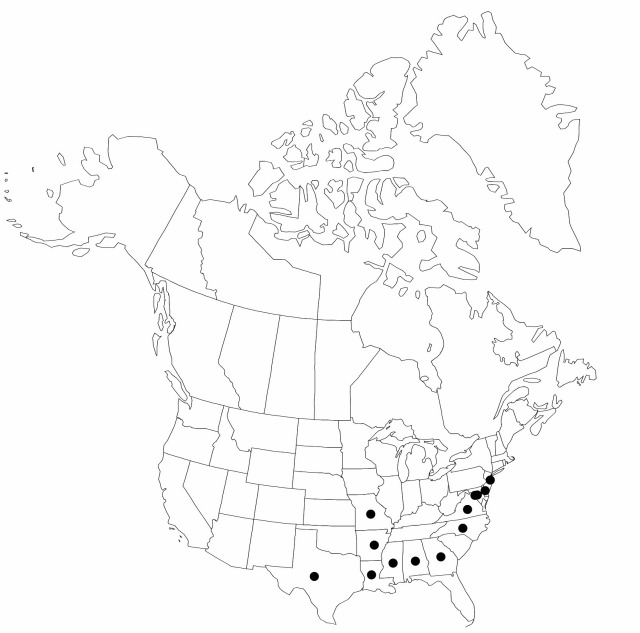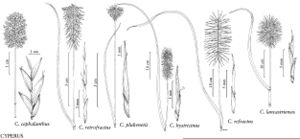Cyperus hystricinus
Rhodora 8: 127. 1906.
Herbs, perennial, cespitose, with well-developed rhizomes. Culms trigonous, 30–100 cm × 2–4 mm, basally cormlike, glabrous. Leaves flat to broadly V-shaped, 20–70 cm × 4–6 mm, glabrous except for marginal prickles. Inflorescences: spikes loosely to densely ovoid, oblong (2 times long as wide), 10–12 × 6–9 mm; rays 6–11, 1–16 cm, glabrous; bracts 5–10, ascending at 30–45°, flat, 6–25 cm × 3–6 mm; rachilla persistent, wings 0.5 mm wide, covering nearly entire length of achene. Spikelets (20–)40–100(–120), proximal spikelets reflexed somewhat, distal ones divaricate, ± terete, lanceoloid, 6–6.8 × 1–1.4 mm; floral scales persistent, 1–2(–3), appressed, golden brown, lanceolate, laterally 5–6-ribbed, 3.8–4.9 × 1.4–1.6 mm, apex mucronate, mucro at most 0.3 mm. Flowers: anthers 1–1.3 mm; styles 0.8–1 mm; stigmas 2–3 mm. Achenes brown, sessile, linear, 2.5–2.8 × 0.5–0.7 mm, apex obtuse, apiculate, surfaces muriculate.
Phenology: Fruiting late summer–early fall (Jul–Sep).
Habitat: Xeric, sandy soils of sand hills and pine barrens
Elevation: 0–200 m
Distribution

Ala., Ark., Del., D.C., Ga., La., Md., Miss., Mo., N.J., N.C., Tex., Va.
Discussion
Cyperus hystricinus resembles C. plukenetii and C. retrofractus; it can be readily distinguished from both by its glabrous culms. Overly mature specimens of C. lancastriensis are frequently misidentified as C. hystricinus; C. hystricinus may be confirmed by its narrow, nearly glabrous leaves and bracts, golden brown spikelets, longer, narrower achenes, and elongated rhizome internodes (to 15 mm vs. 5 mm in 76. C. lancastriensis).
Selected References
None.
